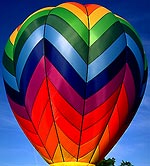JPEG — Joint Photographic Experts Group

 The 16-bit JPEG format (usually written without the E), was designed with photographs in mind. It is capable of displaying millions of colours at once, without the need for dithering, allowing for the complex blend of hues that occur in photographic images.
The 16-bit JPEG format (usually written without the E), was designed with photographs in mind. It is capable of displaying millions of colours at once, without the need for dithering, allowing for the complex blend of hues that occur in photographic images.
JPGs use a complex compression algorithm, which can be applied on a sliding scale. Compression is achieved by ‘forgetting’ certain details about the image, which the JPG will then try to fill in later when it is being displayed. You can save a JPG with 0% compression for a perfect image with a large filesize; or with 80% compression for a small but noticeably degraded image. In practical use, a compression setting of about 60% will result in the optimum balance of quality and filesize, without letting the lossy compression do too much damage.
Though JPGs can be interlaced, they lack many of the other special abilities of GIFs, like animation and transparency.
Simple graphics with large blocks of colour should not be saved as JPGs because the edges get all smudgy.
